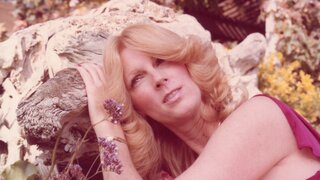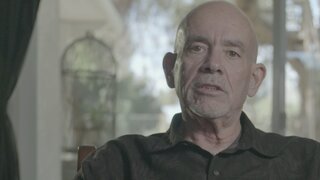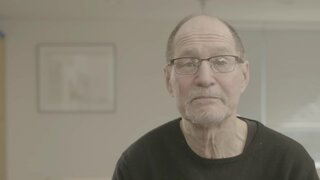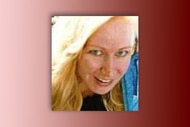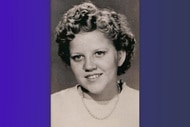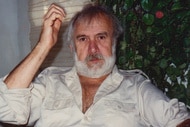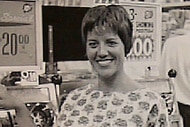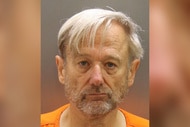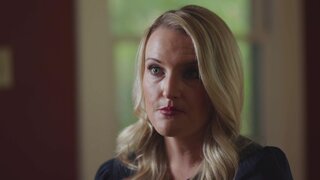Create a free profile to get unlimited access to exclusive videos, breaking news, sweepstakes, and more!
'Jeopardy' Winner Slowly Poisons Wife With Nicotine In Attempt To Get Her Million-Dollar Life Insurance
Doctors were mystified that Linda Kinkade kept falling ill. It would take 20 years after she died for them to discover what had happened to her.
Paul Curry was many things: a scientist, a popular guy, a"Jeopardy" winner ... but was he also Linda Kinkade's murderer?
Linda Kinkade, 45, had beauty and brains, but she felt unfulfilled in her love life. That changed in March 1989 when Curry came to work at the California nuclear power plant where Kinkade was employed.
Together, the couple shared many friends who described Curry as intelligent, charming, and the life of the party.
“He knew a little bit about everything in life,” Kinkade's best friend Merry Seabold told “Charmed To Death,” airing Sundays at 7/6c on Oxygen. “History. Music. And he had just won $60,000 on the program ‘Jeopardy.’”
Friends thought Kinkade and Curry were the perfect couple, and they loved seeing Kinkade happy with a man 13 years her junior who gushed over her.
In 1992, the couple married in Las Vegas. They spent a lot of time together, whether working or cooking at home. Curry loved concocting his own salad dressings and preparing meals for his new wife, sometimes using ingredients from their backyard garden.
But Seabold became concerned when she received a phone call from Kinkade not long after the wedding.
“Paul’s getting real, real intent on getting everything put into his name,” Kinkade told Seabold. “The mortgage, the life insurance, 401k….”
More concerning, Kinkade said Curry wanted to take out a $1 million life insurance policy on her. Kinkade, though, wouldn’t be getting a policy on Curry. Curry insisted that only he needed one on her because of her age. Eager to please her new husband, Kinkade obliged.
Another red flag went up when on one occasion, Kinkade answered the phone and a woman asking for Curry was on the other line: The unknown woman was wondering when Curry's child support would arrive.
A child belonging to Curry was news to Kinkade, and so were Curry’s two previous marriages.
When confronted, Curry confessed his history to Kinkade and profusely apologized. To show just how sorry he was, he booked them a three-day cruise.
What was supposed to be a romantic getaway turned into a seaside nightmare when passengers got sick with a Hantavirus. Kinkade was first to get sick, then Curry. After a few days, Kinkade’s condition worsened, and she required hospitalization that lasted for several weeks.
When Seabold arrived at the hospital, Curry told her to prepare herself for what she was about to see.
“And I wasn’t prepared at all,” Seabold told producers. “And that’s when I knew I could lose my friend tonight.”
Nothing alarming came up in Kinkade’s blood work, and doctors couldn’t understand what was killing her. They wondered if it was a psychiatric disorder, perhaps Munchausen syndrome, where a person intentionally makes themselves sick to receive treatment and attention. Another theory was radiation poisoning, as she’d worked at the nuclear power plant. But Kinkade's symptoms disappeared before doctors could diagnose her.
Although 25 pounds lighter and still weak, Kinkade returned home. The illness even seemed to bring the couple closer together. Curry was affectionate with Kinkade, drawing her bubble baths and being at her beck and call. Over time, she regained some of her health back.
Until New Year’s Eve of 1993, when Kinkade became violently ill, once again. Recognizing that the mysterious sickness was returning, she admitted herself to the hospital.
After one visit to Kinkade, Seabold and her husband stayed with Curry at his house. While there, Seabold found papers about Kinkade's financials and life insurance.
“That’s when I really realized this man is trying to do something to my friend,” Seabold said.
Her suspicions grew when several days later, a nurse at the hospital discovered Kinkade's IV bag had been tampered with. The nurse found a needle puncture in the tubing.
Hospital security called authorities, and detectives from the Orange County Sheriff’s Office interviewed Kinkade at her hospital bed. Investigators recorded the interview and asked her who might want to poison her.
“Well, the only person I can think of that would have a motive to do it would be Paul,” Kinkade answered. “I just don’t want to believe and think that he would do that. He seems like a very good husband.”
Before the investigation could gain traction, Kinkade was released from the hospital. Friends, however, tried warning Kinkade that they suspected Curry was behind her mysterious sickness. It was now 15 months into her marriage, and Kinkade was still suffering from bouts of diarrhea, vomiting, and severe dehydration.
On June 9, 1994, Curry wrote Seabold and asked for help. He said Kinkade was wobbly and incoherent. The next day, she was dead. Kinkade was 49 years old.
Friends and family remained divided over the possibility that Curry had poisoned his wife, and there was never any proof that she was poisoned at all. Curry was then able to collect on the life insurance policy and Linda’s 401K. The case went cold until 2002 when Sergeant Yvonne Shull got hold of Kinkade's file and taped interviews. Shull heard the tapes of Kinkade saying Curry had motive.
“It was like her talking from the grave to me,” said Shull. “That it’s Paul who murdered her.”
Shull dug into Curry's past and discovered that he’d worked at nuclear plants around the country, but he never had a degree. She also spoke with Curry’s two wives before Kinkade, and the second one said she’d also been poisoned by Curry.
“I had no energy, very dizzy, I was… it was very hard for me to get out of bed,” said Curry's second wife. “I saw many doctors. Took many pills. And no one really diagnosed it correctly.”
She was sick for over a year, and Curry asked her to get life insurance. Ultimately, she was rejected, and soon after, Curry left her for Kinkade.
Detective Shull observed that one of the more common reasons to be rejected for life insurance is because people will lie and say they’re non-smokers, but then tests come back positive for nicotine. Referring back to Kinkade’s post-mortem toxicology report, Shull found that Kinkade tested positive for nicotine. Kinkade didn't smoke, though.
The autopsy also showed a small mark behind her ear, but it wasn’t enough to prove that it was a needle puncture at the time the autopsy was performed. In 1994, toxicology analysis wasn’t as sophisticated as it was when Shull took the case on. Shull found that Kinkade's system contained 50-to-100 times more nicotine than that of a regular smoker. Authorities were able to confirm that Kinkade died of nicotine poisoning.
Authorities theorized that Curry put tobacco into Kinkade's salad dressing over a long period of time. Toxicology reports also showed that Kinkade had a toxic amount of Ambien in her system. They believed Curry drugged her before injecting the fatal dose of nicotine behind her ear.
Curry had since moved from California to Kansas. Detective Shull posed as a local officer to let Curry think he had the upper hand. She didn’t want him knowing that she was from California.
In the Kansas interview, Shull had Curry confirm that he was alone in the home when Kinkade passed away. Curry putting himself by Kinkade’s bedside made him the only plausible suspect and was enough to place him under arrest.
On Sept. 11, 2014, nearly 20 years after he killed his wife, Curry stood trial for Kinkade’s murder. The charges against him were insurance fraud and murder in the first degree with special circumstances. On Sept. 30, 2014, a jury found Paul Curry guilty on all charges, and he received the maximum sentence of life in prison without parole.
“[Kinkade] wanted to be loved,” assistant district attorney Ebrahim Baytieh told "Charmed to Death." “She wanted to be treated like a princess, and he did exactly that. He told her what she wanted to hear. But that was the biggest mistake that she made and, unfortunately, she paid for it with her own life.”
For more on this episode and others like it, watch “Charmed To Death,” airing Sundays at 7/6c on Oxygen or stream episodes here.

